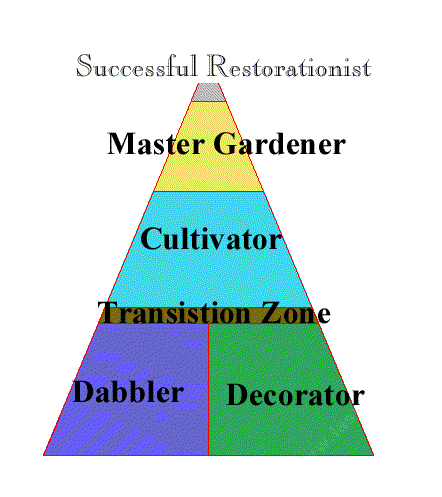Brief introduction to gardening with California native plants
There are many myths passed over back fences about native plants. Most of the good ones are true, most of the bad ones are being spread by people who do not know how to grow native plants, but loudly claim they do.
For the most healthy and long-lived California native plants in your garden, follow these simple rules as much as possible:
Surface Mulch 3-4" deep. Mulch can be shredded redwood or cedar bark, or oak or pine shreddings (great for most chaparral and oak woodland plants), rocks or boulders (great for most desert, valley grassland, and coastal prairie plants) etc. Do Not Use straw, hay, manure or treated wood products..Kill as many weeds as possible.

Plant plants that are appropriate for your location or that can be adapted within reason. A. Go to California native plants and determine which plants are appropriate for your garden given your rainfall, soil, and temperatures.
B. Or, even easier, Go to our plant picker and let us make you a list given your specific garden situation. We have software that will choose a list of plants for your yard. It will ask you how much you water, where you are going to plant etc. Be honest with your answers. If you are not going to water do not put that you'll water twice a week for four hours. If you're cheap and will not buy mulch, put that down. California native plants do not like summer water after the first season, if you enter much summer water expect to get few results
To put it all together in a beautiful landscape first sort the plant list by size, then put the lower plants in front and the higher plants in back. If your shade or water use varies much, you'll need to run the software for each section of the yard that is significantly different. In other words, the shade under an oak that you do not want to water will have a different plant list than the front walk, which is in full sun next to the lawn.
Do not amend the soil or fertilize.
To learn more about soil care please see our Recommended soil care.Do not over water.
To learn more about watering please see our Recommended watering.You can learn more about gardening and landscaping natives by planning at a Simple Garden or Landscape Design
There are different types of gardeners that have completely different views of gardening.
(Adapted from an old Organic Gardening article)Dabblers and Decorators
The dabblers occasionally play at gardening. Dabblers plant some 4" color, mow the lawn and in general do not give the yard a second thought for another month. Decorators plant by color, size, shape, patterns, etc. They think of their garden more often and are involved in it in a more personal way. Days of planning, little gardening, clean hands, piles of plans. Dabblers and decorators get along well and have garden conversations about common garden flowers and colors, as they avoid the actual work of gardening./p>
Most garden clubs are made up of decorators. Many members of the landscape trade are decorators. Decorators will normally have much color, ornaments, trellises, weeds, ticky-tacky, etc. in their garden. Decorators often will make mistakes about dryland plants next to wetland plants, trees in front of windows, overwatering, etc.,Cultivators and master gardeners
Cultivators and above have dirty fingers. Cultivators are the ranchers, farmers and the frustrated farmers. Cultivators are the folks that spend all weekend in their yard mowing, trimming, spraying, planting, tilling, etc. They are the 'Rambos' of the gardening world.
Cultivators often grow a larger garden than they can ever eat, or plant a 1 acre lawn so they can mow it. Cultivators often will become tired of the exertion each week, or learn enough to work smarter and become master gardeners. I'm not talking about the members of 'plant killers anonymous' that take a 40- hour class and become 'maestro' gardeners (40- hour brain surgeons; may they work on each others heads.) Master gardeners read all the best gardening books, visit botanic gardens around the world, buy a house for the garden, and generally live for their garden. Master gardeners often will be in their garden before breakfast, during lunch hour, and until dark. (Sometimes even after dark!) Generally, cultivators and master gardeners have very green thumbs and frustrate to no end the dabblers and decorators who cannot understand why they kill a fifth to one-half of their plants. Master gardeners stick the plant in the ground and it grows! Cultivators and master gardeners often have much in common and can spend hours talking about how to improve their skills. Interestingly, biologists and botanists can be at any level. I know of many biologists that have killed every plant they have ever planted. Some are so bad at gardening they can't even grow weeds. We're trying to pull biologists and gardeners together!?
Most of our customers are the Master Gardener types.



